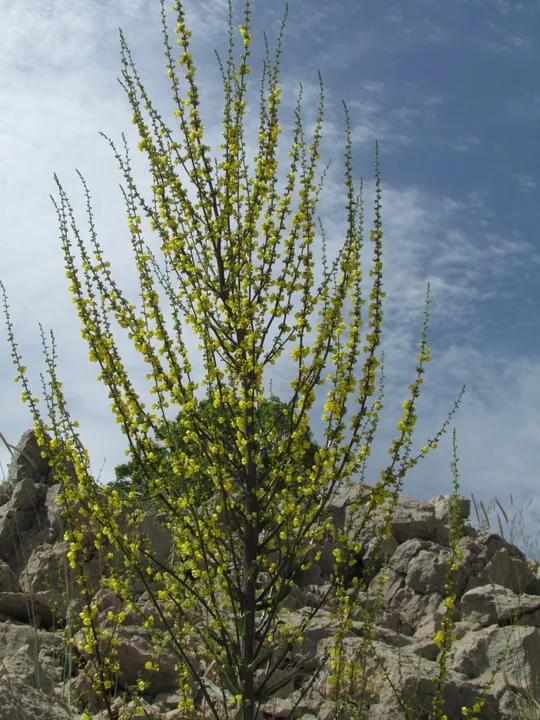Large-leaved Figwort
Scrophularia macrophylla



Scrophularia macrophylla now grows in the Hula Valley, Kinarot Valley and the Golan Heights regions. There
are 41 documented sites in these regions, but some of them have probably disappeared
because of drainage and agricultural development. According to current estimates,
the species is now found at only circa 30 sites in the country. In the Hula Valley,
it appears in the eastern and western springs, in the Hula Reserve, in the Dan
and Snir (the Hatsbani Stream) streams and in Nuhela. In the Golan, S. macrophylla grows in the western springs and
streams, from the area of Samakh Stream up to the En
Notera (Tina) area. The species was also found in the northern Golan
Heights, at the Banias and even at higher altitudes in Lake Ram. In the Kinarot Valley, it is recorded at several sites on
the northeastern shores of the Sea of Galilee (Lake Kinneret) (from Maǧrasa-Dalyot stream). According to data from the
Jerusalem Herbarium it once grew in three additional regions: the Upper Galilee
(Amud Stream in 1926 and Wadi Meron in 1925), Lower Galilee (Mount Yavne’el,
1925 and Migdal, 1922) and even in the lower Jordan Valley (from the Elisha
Spring in Jericho, 1912). However, it has not been found since then at these
sites and regions.
Stream banks,
edges of springs, swamps and marshy areas at the edge of streams.
For the genus – see Scrophularia hierochuntina.
S. macrophylla belongs to the large genus Scrophularia
that is characterized by its large, undissected-pinnate leaves. This group is
typical of northern and more humid areas than Israel. The northern distribution
limits of the species in Turkey are not clear and require taxonomic study to
clarify whether S. macrophylla is a Levant species
as we believe today, or a more widely distributed species with different local forms
or varieties, and which species are related to it.
•
The range of Scrophularia macrophylla in Israel has been significantly reduced
and it is now found in only three regions and has become extinct in three other
regions.
•
In the regions
where the species is found there is a decreasing trend in the number of sites.
•
In most cases, S. macrophylla grows as a single individual plant and
does not form large populations.
•
The factors
related to the deterioration of wetlands in Israel – drying, pollution and
disturbance – have led to the extinction of S. macrophylla
at sites where it had been found in the early 20th century, in the Upper
Galilee, Lower Galilee and the Jordan Valley. These factors remain a threat for
the sites remaining today.
•
S. macrophylla
is protected in several nature reserves of streams and springs in the Hula
Valley: the Tel Dan nature reserve, Snir Stream reserve, Hurshat Tal Reserve, Te'o Spring (Ǧahula)
Reserve and the Hula Reserve.
•
The information from
other countries regarding this species is limited. To the best of our knowledge,
it is not included in red books.
Scrophularia macrophylla
individuals and populations in nature reserves should be monitored and the
quality of water in these reserves should be maintained. Reintroduction should
be attempted in wetlands and streams where the water quality is good.
Scrophularia macrophylla is found
Israel, Lebanon, Syria and northern Iraq. The identities of collections from
Turkey are problematic – some were identified as S. umbrosa, a species
with a winged stem, and the identity of other specimens is doubtful.
Scrophularia macrophylla
is an herbaceous perennial of clean wetlands in the northern Israel. There
is a continuous decline in the number of regions and in the number of sites where
it is found in Israel. Its main threat factor are the drying, pollution and
other disturbances of the highly sensitive aquatic habitat. S. macrophylla is
protected in several nature reserves in the Hula Valley. There is no available information
regarding the state of preservation and protection in other countries.
Current Occupancy Map
| 1000 squre meter pixel | 5000 squre meter pixel | 10000 squre meter pixel | |
|---|---|---|---|
| number of observations | 0 | 0 | 0 |
| in total pixels | 0 | 0 | 0 |
| Family | Scrophulariaceae |
| Classification | On the endangered species list |
| Ecosystem | Scrophularia macrophylla |
| Chorotype | Eastern Mediterranean – Western Irano - Turanian |
| Conservation Site | Dan Stream and Tel Dan Nature Reserve |
| Rarity |
1
2
6
|
|---|---|
| Vulnerability |
0
3
4
|
| Attractiveness |
0
0
4
|
| Endemism |
0
0
4
|
| Red number |
1
3.2
10
|
| Peripherality | N |
| IUCN category | DD EW EX LC CR EN VU NT |
| Threat Definition according to the red book | Vulnerable |
 Based on:
Based on:






